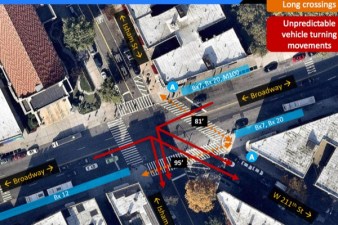CB 12 Committee Endorses Ped Improvements at Chaotic Inwood Intersection

Long-awaited improvements to a hazardous Broadway crossing in Inwood could be implemented next year, if Community Board 12 passes a resolution that cleared the board’s transportation committee this week.
The committee and around 50 residents gathered Monday night to hear DOT’s proposals for the intersection of Broadway, Dyckman/200th Street and Riverside Drive [PDF], where pedestrians must negotiate long crosswalks and signals that force them to look out for drivers coming from different directions simultaneously. In addition to local traffic, the intersection is consistently clogged by motorists headed to and from the West Side Highway and those who drive through Inwood to avoid tolls on the Henry Hudson Bridge.
There were 128 crashes at the intersection from 2010 to 2012, DOT said, resulting in injuries to three cyclists, five pedestrians, and 10 vehicle occupants. Thirty-five pedestrians and cyclists were injured there between 1996 and 2009, according to Transportation Alternatives’ CrashStat.
DOT’s suggested remedy is a relatively simple mix of turn bans, signalization tweaks, new signage, and enhancements to pedestrian space. DOT would prohibit left turns from northbound Broadway onto Dyckman and Riverside, left turns from Dyckman to southbound Broadway, left turns from southbound Broadway to Dyckman, and U-turns from Riverside to Dyckman. DOT proposes to add paint or concrete to two pedestrian islands on the west side of the intersection, and to extend the curb on the southeast corner. These alterations would shorten crossing distances and eliminate conflicts between pedestrians and turning drivers at the west and south crosswalks.

Alternate routes for motorists would be marked with new signage. DOT staff said peak hour counts showed that the impact on residential streets, where auto traffic would be directed, would be minimal. Still, objections to the plan centered mostly on diverting traffic to narrower streets that are lined with apartment buildings.
Several locals said the plan should take into account the overwhelming number of drivers who are drawn to the area by La Marina, a restaurant and nightclub at the west end of Dyckman Street that offers valet parking. Maria Luna, former CB 12 chair and current board member, and resident Bryan Davis yelled for a while about how the turn bans would make it more difficult to drive in the neighborhood, especially since Broadway is usually lined with double-parked vehicles.
DOT Manhattan Borough Commissioner Margaret Forgione said longer green signals for Broadway and Riverside traffic would mean less congestion on Broadway. DOT staff and committee member Elizabeth Lorris-Ritter also noted that the plan is intended to address pedestrian safety at the intersection, and won’t solve all of the area’s traffic problems.
Other residents who spoke hoped the plan would be enough to make the intersection safer for pedestrians, many of whom cross there with children on the way to and from nearby playgrounds and Fort Tryon Park. Streetsblog reader Jonathan Rabinowitz questioned why the proposal, which has been in the works for at least two years, was so long in the making. “We have not neglected this community board,” replied Forgione.
DOT has made street improvements in Inwood and Washington Heights in recent years, and Inwood was selected for Manhattan’s first Slow Zone. But the Broadway/Dyckman/Riverside intersection is one of the most heavily trafficked in Inwood, and one of the most dangerous.
Last spring DOT proposed a number of bike lanes concentrated in Washington Heights, one of them to be protected by parked cars, two years after CB 12 asked the agency to study ways to “[connect] existing bike lanes and [create] safe ways for cyclists to move uptown, downtown, and across town.” Meanwhile, DOT traded bike lanes for sharrows on one Inwood street, and removed a bike shelter on Dyckman. A citizen-generated proposal for a protected bike lane on Dyckman Street, connecting the east- and westside greenways, has languished for over five years.
When a resident asked about increasing the amount of time pedestrians have to cross Broadway on the north side of Dyckman, DOT staff said it could only be considered if signal times were shortened at other crossings.
Residents at the meeting voted in favor of the proposal, and the board unanimously approved a resolution in support. The committee added clauses concerning NYPD’s lack of enforcement against speeding and double parking, a request for red light cameras, and auto traffic related to La Marina. The reso requests that DOT follow up with traffic count data on the alternate motorist routes. If CB 12 approves the resolution at its next meeting, set for November 26, DOT could get started on the project next March.
After the room had for the most part cleared, DOT previewed changes at another Broadway intersection south of Dyckman, at Nagle and Bennett Avenues, where DOT would use concrete sidewalk extensions to shorten crossing distances and square up “soft” right turns. DOT plans to eliminate an existing Barnes Dance crossing phase, so pedestrians would have to look out for turning drivers. DOT staff said signals would be timed to facilitate more vehicle turns from Nagle to Broadway.
The proposal would add eight parking spaces, a feature that brought applause from committee members, who endorsed the plan unanimously.
